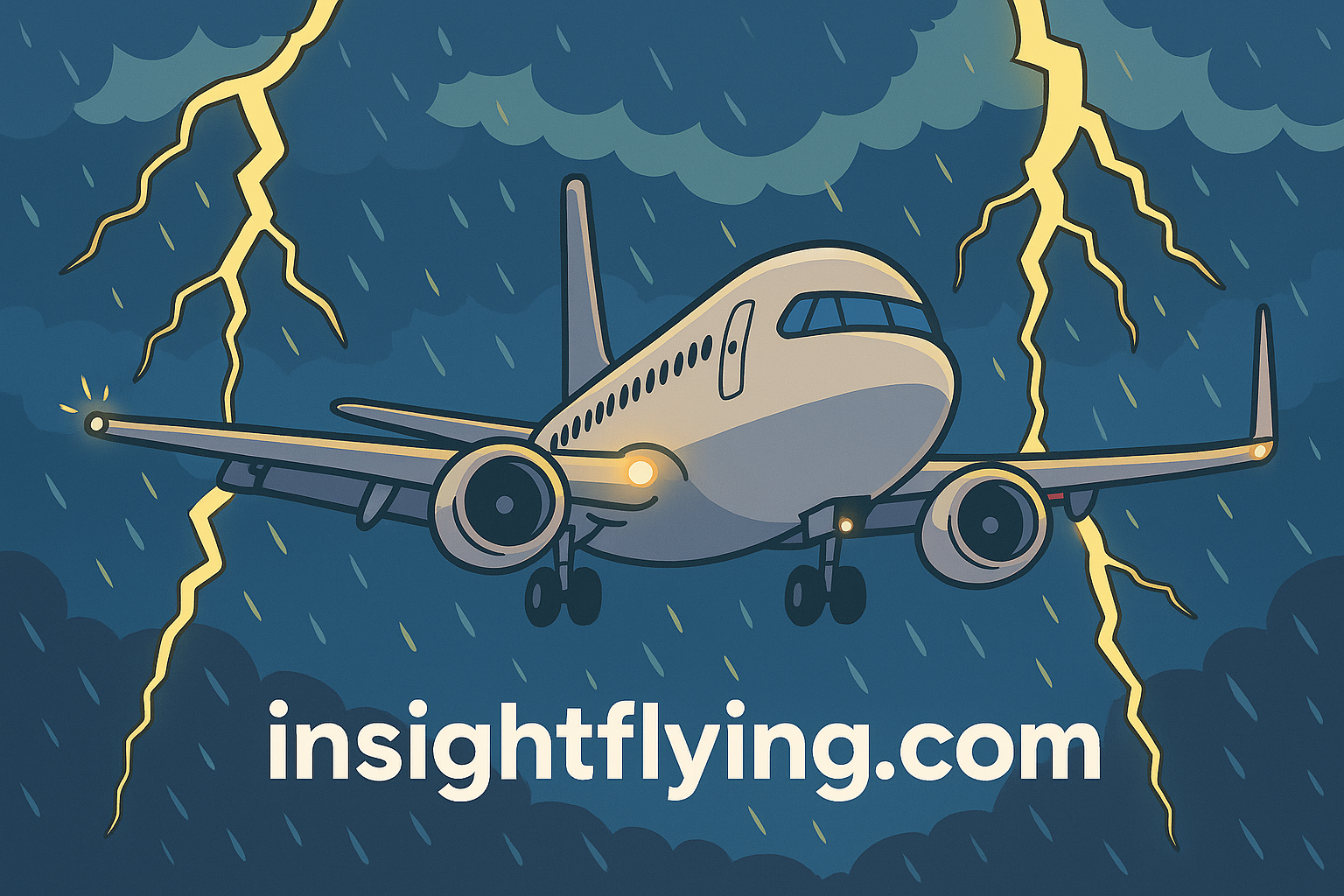ตอนกลางวัน เราสามารถมองเห็นไกลสุดสายตาได้ หากท้องฟ้าโปร่งใส แต่ถ้ามีเมฆแผ่นใหญ่บดบัง ก็จะเห็นเป็นฝ้าขาว ๆ เต็มไปหมด
พอตกกลางคืน ความท้าทายจะยิ่งเพิ่มขึ้น นักบินต้องระมัดระวังมากขึ้น โดยเฉพาะในช่วงฤดูมรสุม อุปกรณ์สำคัญที่จะช่วยเป็นเหมือน “ดวงตาคู่ที่สอง” ของนักบินก็คือ เครื่องตรวจอากาศประจำเครื่องบิน – Airborne Weather Radar
ตามกฎหมายอากาศยานสากล เครื่องบินพาณิชย์ทุกลำที่บินในเส้นทางที่อาจมีอากาศเลวร้าย ต้องติดตั้งและใช้งาน Weather Radar ได้สมบูรณ์ ไม่เช่นนั้นจะไม่สามารถบินได้ ปกติพวกนักบินจะเรียกสั้น ๆ ว่า “Weather Radar” แต่ผมเติมคำว่า Airborne เพื่อแยกออกจาก Ground Wx Radar ที่ติดตั้งอยู่กับสถานีภาคพื้น (ซึ่งสนามบินสุวรรณภูมิก็กำลังจะมีการติดตั้ง ถือเป็นข่าวดีมาก ๆ)
หลักการทำงานของ Weather Radar
Weather Radar จะใช้การส่งคลื่นออกไป แล้ววัดการสะท้อนกลับมา แสดงผลเป็น สีต่าง ๆ ตามความรุนแรงของอนุภาคในอากาศ ได้แก่
- เขียว → เบา (light)
- เหลือง → ปานกลาง (moderate)
- ส้ม → หนัก (heavy)
- แดง → รุนแรงมาก (severe)
ทั้งหมดนี้จะแสดงผลบนจอ Navigation Display (ND) ที่อยู่ตรงหน้านักบินทั้งสอง ซึ่งจอนี้ไม่ได้แสดงแค่เรื่องอากาศ แต่รวมข้อมูลสำคัญหลายอย่าง เช่น
- เส้นทางบินและ Waypoint ข้างหน้า (ได้ไกลถึง 1,000 กิโลเมตรแล้วแต่เครื่องบิน)
- ทิศทางลม
- ความเร็วเครื่องบิน
- ข้อมูลภูมิประเทศ (Terrain map)
- และ Weather Radar Display ที่เป็นพระเอกของเรื่องวันนี้
นักบินสามารถปรับมุมการยิงคลื่นได้ ไม่ว่าจะเป็นมุมก้ม (Tilt Down) หรือมุมเงย (Tilt Up) เพื่อให้มองเห็นมวลอากาศในระดับต่าง ๆ จากนั้นใช้ความรู้และประสบการณ์ในการตีความภาพสีบนจอ ND
การบินกลางคืน – อันตรายที่มองไม่เห็น
ถ้าคืนไหนมีแสงจันทร์ แม้เพียงเสี้ยวเดียว ก็ช่วยให้มองเห็นเค้าโครงเมฆได้บ้าง แต่ถ้าเป็นคืนเดือนมืด บวกกับอยู่ในเมฆบาง ๆ ก็เหมือนอยู่ในห้องมืดที่ปิดไฟหมด มองไม่เห็นแม้แต่ดวงดาวเลย
ในสภาพแบบนั้น Weather Radar จะกลายเป็นพระเอกทันที เพราะช่วยเปิดเผยสิ่งที่ตาเปล่าไม่สามารถเห็นได้
กำแพงสีแดง – เมฆคิวมูโลนิมบัส (Cumulonimbus)
เมฆคิวมูโลนิมบัส หรือที่นักบินเรียกสั้น ๆ ว่า Cb คือสิ่งที่อันตรายที่สุดบนท้องฟ้า ผมเคยถ่ายภาพก้อนเมฆนี้ในคืนเดือนมืด แสงฟ้าแลบในเมฆเพียงเสี้ยววินาทีทำให้เห็นรูปร่างก้อนมหึมา แล้วก็มืดสนิทอีกครั้ง
บนจอ ND เมฆนี้จะแสดงเป็นปื้น สีแดงจัด หมายถึงความไม่เสถียรของมวลอากาศขั้นรุนแรง หากบินเข้าไป เครื่องบินจะสั่นสะเทือนอย่างหนัก ถึงขั้นที่กระเป๋าเก็บเหนือศีรษะ (overhead bin) อาจหล่นลงมาทับผู้โดยสารได้เลย
ดังนั้น นักบินจึง ไม่บินฝ่าเด็ดขาด แต่จะเลือกอ้อมออกไปไกล ๆ เพื่อความปลอดภัย
✈️ สรุปสั้น ๆ:
ตอนกลางคืน เมื่อดวงตาของมนุษย์มองไม่เห็น อุปกรณ์อย่าง Airborne Weather Radar จึงกลายเป็นเครื่องมือสำคัญที่สุด ที่ช่วยให้เรามองเห็นอันตรายที่ซ่อนอยู่ และนำพาผู้โดยสารทุกคนไปถึงจุดหมายได้อย่างปลอดภัย
Flying in Weather – Part 3
During the daytime, pilots can usually see far ahead, as long as the sky is clear. But when a solid cloud layer blocks the view, all we see is a wall of white.
At night, it gets even more challenging. Flying in darkness requires extra caution—especially during the monsoon season. This is where technology steps in to serve as the pilot’s second pair of eyes: the Airborne Weather Radar.
By regulation, all modern commercial aircraft must be equipped with a functioning weather radar if they operate in areas where adverse weather may occur. Without it, flying through such routes would be prohibited. Pilots typically just call it “Weather Radar,” but I emphasize the term Airborne Wx Radar to distinguish it from Ground Wx Radar, which is installed at airports. (Suvarnabhumi Airport, for example, is in the process of installing ground radar systems—a very welcome development.)
How the Airborne Weather Radar Works
The airborne radar displays weather information in different color-coded intensity levels—green, yellow, orange, and red—projected on the Navigation Display (ND), which sits in front of both pilots.
The ND integrates multiple layers of essential flight data into a single screen:
- Current flight path and upcoming waypoints (up to 1,000 km ahead depending on aircraft type)
- Wind direction
- Aircraft speed
- Basic terrain map
- And most importantly here, the Weather Radar Display
The radar works by sending out beams and analyzing the reflected energy. Pilots can adjust the beam angle—Tilt Up or Tilt Down—to scan different slices of the sky. Interpreting the resulting colors and shapes requires both technical knowledge and real-world flying experience.
Flying at Night – The Invisible Hazard
On nights with a bright moon, pilots may still see the outline of clouds ahead. But on moonless nights, it can be pitch-black—like sitting in a room with every light turned off. If the aircraft is also inside thin cloud layers, not even stars are visible. In such conditions, the Weather Radar becomes the hero of the cockpit, guiding the pilots through invisible dangers.
The Red Wall – Cumulonimbus Clouds
Take for example a Cumulonimbus cloud (Cb), highly active and dangerous. I once captured a photo of such a storm cloud on a moonless night. A flash of lightning inside the cloud briefly illuminated its massive shape—then everything went dark again.
On the ND screen, this kind of cloud shows up as a large deep red area—a clear warning sign. Red means severe instability and violent air masses. No pilot should ever attempt to fly through it. The aircraft would be shaken violently, and unsecured baggage could easily fall from overhead bins onto passengers.
That’s why pilots are trained to avoid thunderstorm cells by a wide margin, never by trying to “squeeze through.”
✈️ In short:
At night, when human eyes fail, the Airborne Wx Radar becomes a vital tool to keep both the pilots and passengers safe. It reveals what cannot be seen—helping us steer clear of the most dangerous weather in the sky.
หนังสือการบิน ทางลัดสู่ความเข้าใจที่นำไปใช้งานจริง

|
|

|
|

|
|

|
|

|
|
ขายดีที่สุด

|
|
